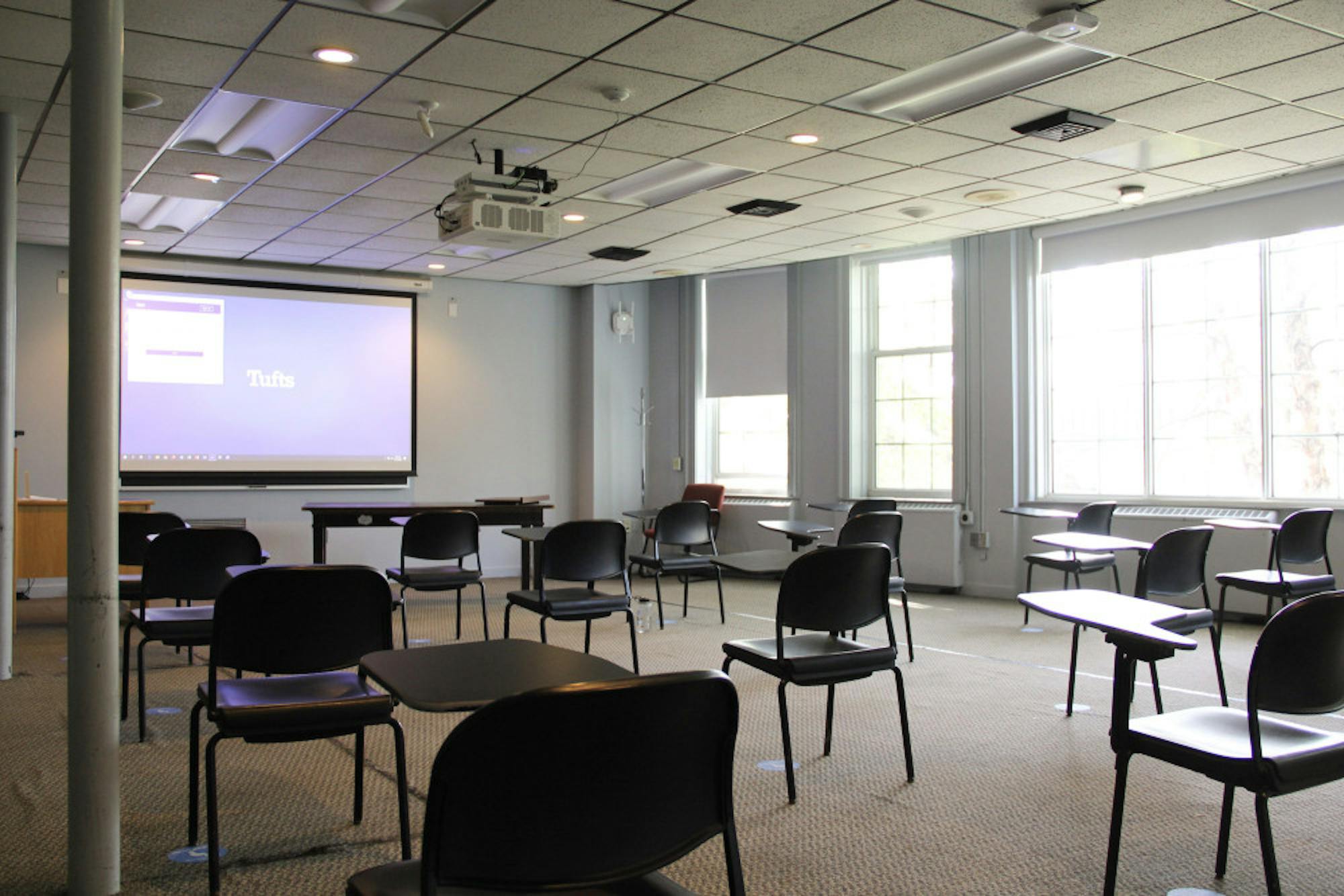Joshua Lim is in his first semester at Tufts, taking a set of courses common for first-years: introductory classes in biology, biostatistics and community health, as well as a music theory course. In addition to the usual challenges of transitioning to college, Lim attends classes from his home in South Korea — 13 hours ahead of the Eastern time zone.
“By the time I reach my 4 or 5 a.m. class, I’m a little worn out,” Lim said.
Lim is one ofover 700 Tufts students studying remotely this semester, and for the first-years among them, the entirety of their college experience so far has been online. These members of the Class of 2024 face a unique set of challenges, starting life at Tufts in a manner unlike any previous class. They expressed a variety of reasons for choosing to be remote this fall.
For Lim, safety was a significant concern.
“When I chose to do online, it was partially because I was kind of scared ... the numbers [in the U.S.] were quite intense compared to here in Korea,” Lim said.
According to Johns Hopkins University, South Korea has faced just 393 deaths from the virus since the start of the pandemic. The U.S. has surpassed 200,000 deaths.
“In terms of coronavirus response, Korea’s been pretty hardcore,” Lim said. “At certain times back in February and March, we basically just didn’t go outside at all. Without question, all institutes, all colleges, all schools were shut down.”
Multiple first-years cited concerns that campus could close early, forcing students to leave Tufts and return home.
“As a family, we decided that we didn’t want to risk coming and then getting sent back home shortly after,” Victoria Zhang, a first-year living in Maryland, wrote in an email to the Daily.
Suhasini Mehra, a first-year living in Switzerland, said traveling internationally concerned her.
“If anything happened, if I wasn't able to come home, or something, because of the travel restrictions, I didn’t want to risk that,” Mehra said. “I’d rather be home for that during this first semester, make sure that everything goes well, and then hopefully, if nothing goes wrong, I’ll be able to come in January.”
For other students, however, coming to campus was never an option.
“It wasn’t much of a choice,” Ayomikun Adeyanju, a first-year living in Lagos, Nigeria, said. “U.S. embassies aren’t open here, so I can’t get my visa processed.”
Sebastián Fernández, a first-year living in Paraguay, faced the same issue.
“The embassies are closed,” he said. “They are not issuing visas.”
Once enrolled in a virtual semester, a new journey began, and Fernández found himself satisfied with the first step of that journey: pre-orientation.
“It was really fun, and I really got to know my classmates, so everything went really well,” Fernández said of his experience in Tufts Global Orientation (GO). “We basically did everything that GO participants do when they’re in person.”
Other students also testified to the value pre-orientation programs had for meeting other students, particularly in the virtual setting. Mehra took part in the Cultivate Relationships by Engaging with Arts at Tufts Experiences program, also known as CREATE.
“It was a useful way to get to know some people and have a point of contact from the start,” Mehra said.
This year,all pre-orientation programs were fully online. It was one of few parts of life at Tufts so far to offer the same experience to remote first-years and their in-person peers.
“During pre-o, a lot of others hadn’t moved onto campus yet, and since everyone was virtual, there was no FOMO,” Zhang said, referring to the “fear of missing out,” or FOMO.
Once pre-orientation and orientation were over, remote first-years began their first classes in college. For those living in different time zones than the Tufts campus, attending synchronous classes became an immediate challenge.
“The time difference is probably the biggest challenge for me,” Lim, who is 13 hours ahead, said. “It was a struggle to get used to.”
Ethan Chen, a first-year living in Taipei, Taiwan, is 12 hours ahead of the Eastern time zone.
“I have to manage my time quite wisely, because all the courses are at night,” Chen said. “I had to change my sleep schedule a little bit.”
In addition to the issue of timing, teaching virtually can pose challenges to learning and participating within the class.
“I’m not actually that comfortable talking to a screen on Zoom,” Chen said. “I actually prefer talking in person, face-to-face. That’s my challenge that I’m still facing.”
This also poses a problem in hybrid classes, where some students attend in person and others remain remote.
“Most people are attending in person, and there’s just like two of us that are on Zoom, kind of projected up on the smartboard at the front of class,” Mehra said about her one hybrid course. “It’s been the hardest one, because it’s hard to have discussions when most people are in the classroom, and then some people are online.”
Some remote first-years mentioned difficulty connecting and communicating with professors, which take place over Zoom.
“It has felt hard to build relationships with professors remotely,” Zhang wrote. “Since half of my classes are asynchronous, it’s easy to feel invisible to the professor. Also, I feel like Zoom office hours are even more intimidating than in-person office hours.”
Zhang wasn’t the only student to feel intimidated by signing up to meet with professors for virtual office hours. For Mehra, the idea of logging on for a Zoom call felt less natural than simply visiting a professor’s office in person.
“The concept of office hours is really new, especially as a first-year," Mehra said. The Zoom format makes it even weirder. You can’t go to a door and see if it’s open or if somebody’s inside, you just show up at a Zoom and then maybe somebody’s in the middle of a conversation. So I feel nervous to do stuff like that.”
Lim and Fernández both spoke of having similar apprehensions. But once they had given office hours a try, they changed their tune.
“The concept of office hours, one-on-ones, was a bit new to me, because it didn’t really exist when I was in high school,” Lim said. “Because I was curious, I tried signing up for a few of them ... and, without a doubt, it’s given me a chance to really connect with my professor.”
Fernández offered similar testimony.
“One of the things that worried me the most before I started the semester was the office hours, because I know those are a great thing when you’re in person and they’re really helpful, and I was just worried that I was not going to be able to experience that,” Fernández said. “But ... I already did office hours with some of my professors, and they’re just really helpful. They manage to help us virtually. On Zoom, they put up whiteboards, they explain everything ... I feel really supported by Tufts.”
While office hours are available for students determined to meet their professors, there is no institutional equivalent for students looking to meet their peers. The challenge of meeting people and making friends in the virtual setting is a consistent problem for first-years starting college remotely.
“I see my classmates through the screen. We set up GroupMe's for any group projects and things like that, but that’s probably the limit,” Lim said. “I haven’t really gotten to a friend level with anybody just yet.”
Online learning removes some of the opportunities to meet people in college. Instead of talking with classmates after class or bumping into them outside, students log off of Zoom calls and return to being on their own.
“It’s kind of lonely,” Adeyanju said. “I like being around people. I like meeting new people. With virtual learning, after class you just face your own work.”
Irene Yoo, a first-year living in Fullerton, Calif., described the remote experience as a challenge socially, particularly when many other first-years can socialize in person.
“It’s kind of frustrating to not be there. I really want to be on campus and make friends, and I get FOMO when I see Snapchats of people meeting up,” she said. “I’m like, ‘I want to be there,’ but I can’t.”
Fostering deep connections and forming lasting friendships aren’t the only struggles of the remote experience. Without living in the same environment as their classmates, remote students also face higher barriers to simpler connections, like finding people to collaborate with on day-to-day work.
“Some students meet on campus to do their homework,” Fernández explained. “I don’t have that option, so if I want to study with someone, it has to be through Zoom. I have to find someone that is willing to do that, because I know that a lot of people are not really fans of the platform.”
For all first-years, navigating classes and assignments can be challenging in the transition to college. But remotely, students do not have peers around them dealing with the same issues.
“It’s been difficult feeling on top of things,” Zhang wrote. “There are a lot of small assignments for my classes, and they put them in different places on Canvas, so I’m always afraid that I’ve missed something. I also don’t like not being surrounded by other Tufts classmates — it does feel lonely when you have to keep track of everything yourself.”
Beyond issues within the classroom, Zhang also described difficulties getting involved in extracurricular aspects of the Tufts experience.
“It’s hard finding clubs to join,” she wrote. “I also wanted to get an on-campus job this semester.”
Normally, clubs would offer pre-existing communities, available for students interested in meeting more people. But Mehra, like Zhang, also mentioned barriers toward getting involved in that part of life at Tufts as a remote student.
”I have a long list of clubs that I’d like to join in January if I get to come to campus," Mehra said. "But for now, everything is [at] like, 3 a.m. for me. So that’s a part of campus life that I feel like I’m really missing out on, and it’s, you know, it’s just kind of sad.”






